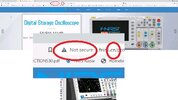The best advice I can offer anyone getting into the hobby is to buy the best scope you can afford, not the cheapest one that will simply "get you by". If you get the cheapest one, you will be replacing it every time your skills improve, and that budget hardware will add up to a good scope's cost real fast.
Even for those looking at one for HF use, even if you never intend to exceed 30MHz, you still want the ability to see higher, much higher. Today's transistors, even a 2N3904, can burst into VHF and UHF parasitic oscillations, You will need to be able to see that if you are serious about working on radios.
My first (and to this date, only) scope is a Picotech 3206D. Its been dropped several times in the field (once from a tree 15' up), it's saw the direct output of a CB radio (which it can safely do with legal-limit radios terminated in 50Ω), and I even overloaded it with a bad attempt at a DIY capacitive spark plug cable probe. It still works good! And the FFT spectrum analyzer option goes low enough to strongly detect the earth's schumann resonances when I toss a wire in our lake ~ whereas my siglent SVA1032x (over 2x the price and designed to be a spectrum analyzer) can't even do that! If you can spare the change, it's a great starter scope/sa that will not only take your abuse but also hang in there as your skills advance. The ratings are conservative (such as bandwidth - marketed as 200MHz, measured at 235MHz, and can display waveforms, albiet heavily attenuated, well past 500MHz). The only thing I don't like about it is that the spectrum analyzer picks up internal birdies at 62.5MHz and 125MHz, but that hasn't been an issue yet. And since I bought it 5+ years ago, it's went up in price, not down. A good investment.


